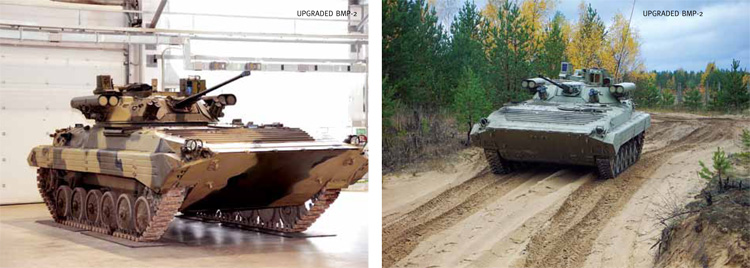- Prime Minister Narendra Modi inaugurates Aero India 2023 in Bengaluru; Releases Commemorative Stamp
- Defence Secretary meets delegations from Saudi Arabia, USA and Oman on the sidelines of Aero India 2023
- Foreign Ministers of 32 countries to attend Aero India 2023
- Embraer showcases the C-390 Millennium at Aero India 2023
Combat Module for Armored Vehicles Upgrade

Russian infantry fighting vehicle BMP-2, being the main combat vehicle of multiple countries’ land forces, was adopted for service in 1980 and used to exceed most of its foreign counterparts in terms of combat capabilities. Nowadays BMP-2 still basically meets the modern requirements.But the analysis of current state and development tendencies of weapons and fire control systems shows that BMP-2 weapon system is falling behind the modern level in a number of parameters.
The firepower of a combat vehicle is determined by its weapon system, thus, the increase of combat efficiency may be achieved by weapon system modernization. BMP-2 has a high weapon system upgrade potential. The challenge of increasing the firepower of existing BMPs providing their superiority over other modern vehicles has been successfully met by KBP Instrument Design Bureau.
The upgrade was implemented on a serially produced BMP-2 turret with 2A42 automatic cannon. The weight of add-on equipment installed does not exceed 500kg, including around 260 kg of extra ammunition: 30mm grenades and ATGM.
The results of upgrade of BMP-2 with new B05Ya01 combat module are as followed:
- due to introduction of day/night FCS the system provides accurate firing with all types of weapons, including guided, at moving and stationary targets, round-the-clock engagement of all types of targets from stationary position, on the move and afloat at the range up to 4000m with automatic cannon, up to 2100m with automatic grenade launcher, up to 5500m with 9M133-1 ATGM. Besides, 9M133M-2 ATGM with tandem shaped-charge warhead and 9M133FM ATGM with HE warhead and 9M133FM-3 ATGM with HE warhead and proximity fuse, recently designed by KBP, allow firing at range up to 8km;
- Kornet-E ATGM penetration capability, increased up to 1100-1300mm, allows reliable engagement of modern advanced tanks fitted with add-on ERA. Due to stand-off range targets engagement capability the upgraded BMP-2 are sure to prevail in combat with enemy tanks and IFVs.
- Installation on two stabilized launchers of BMP-2 ICV of four ready-tolaunch guided missiles significantly increase fire rate when firing ATGMs. This excludes the necessity to reload the guided missile launcher during the combat;
- Implementation of TV-IR-auto target tracker enables to increase the accuracy of target tracking 3-6 fold in comparison with manual tracking. Automatic target tracker adds the FCS a qualitatively new feature, implementing the “fire-and-forget” principle when firing a guided missile. At the same time the missile cost is significantly lower than that of a missile with a seeker which fulfils the function of the auto-tracker.
- The possibility of KORNET ATGM launch in an elevated mode almost excludes the possibility of detecting the missile by the enemy.
- Laser guidance mode of the ATGM with orientation of the missile within the laser beam provides for high jamming-immunity against all types of active jamming, since the jammer cannot be behind the ICV and send the same encoded messages.
- To overcome systems of targets’ active protection and to provide for guaranteed engagement of crucial targets salvo launch of 2 ATGMs riding on one laser beam is provided.
- Effective firing range of a 30-mm projectile was increased from 1100-1400m up to 1800-2000m.
- Air defense firing effectiveness increases significantly: kill probability by automatic gun when firing against “helicopter” and “low-flying attacking aircraft”-type target increases dramatically and its value approaches that of specialized gun and missile air defense systems of closed ranges with much lesser expenditure of ammunition.
- Effective engaging of enemy’s personnel at ranges up to 2100, including that behind the accidents of ground and in trenches due to the implementation of low ballistics armaments (AG-30M automatic grenade launcher) with new GPD-30 rounds.
- The opportunities of CV commander increase due to installation of night vision panoramic sight with technical view, implemented on ICVs for the first time. This allows to increase the stream of targets detected by the CV by 2.5 times, increase TD accuracy for the gunner by 10 times and to fully backup his tasks as well as to carry out engagement of aerial targets in automatic mode.
BMP-2 upgrade meets the requirements towards future infantry combat vehicle for the nearest 20-30 years, and upgraded BMP-3 ICV can be successfully used till year 2030-2040.
The carried out upgrade features a systematic approach and leads not simply to enhancement of separate technical specifications of the system, but has enabled to create a vehicle with qualitatively new feature, which can successfully compete with foreign counterparts on the weapon market.
Combat module is also meant for BMP-1 upgrade of (after the chassis is upgraded to up to the level of BMP-2), BMP-3, BMD-3 airborne combat vehicle, BTR-90 APC and has passed the trials on their chassis. KBP carries out the lot production of upgraded BMP-2 combat compartment.
Advertorial is based on the article of N.I. Khokhlov, L.M. Shvets, I.A. Matveev, O.A. Borovykh.





